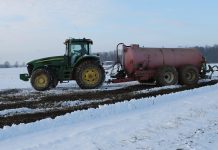How has fertilizer prices impacted forage production on your farm? How do you think fertilizer prices will influence your production in the future? Can you afford to spread fertilizer on hay and pasture fields these days?
Are you sure you can afford not to spread fertilizer on your fields? How are farmers going to be able to stay in business?
These are just a few questions I’ve heard discussed in conversations this summer. Obviously, no single or simple answer can be given because each farm is different.
Things to ask yourself
The purpose, the objectives, the resources and the financial situation vary greatly in everyone’s operation. There are however, things we can key in on as we look for answers to these questions.
A few things I might ask are: Do you have good records (more than numbers you used on tax schedule F) to help you make decisions?
Are you managing your forages to include clovers or other legumes in pastures and hay fields to reduce the need for additional nitrogen and still try to maximize forage yields?
Are you rotationally grazing to manipulate livestock so the manure deposits are uniformly distributed over your fields to let forage plants take advantage of the nutrients going through the livestock?
Have you had your farm’s soil tested within the last four years to know the nutrient values in your soil? Is the pH of your fields 6.0 or better?
Do you know how much organic matter is in your soil?
If you can answer yes to each of the second set of questions you can probably answer many of the first ones mentioned.
Good records
First of all, good records help! When decisions must be made, managers with good records have a distinct advantage over those who don’t. When one knows production costs for each part of their operation they can more easily calculate when to apply or not apply nutrients.
Knowing what nutrient and organic matter levels are in each field from soil testing is helpful, too! Eliminating much of the guess work can pay big dividends when nutrient values are as expensive as they are now.
If you use just 100 pounds of fertilizer more than necessary on a field, because you are guessing how much fertilizer to apply, the cost of those two extra bags would have been enough to run soil test on five fields.
Costs you money
If you don’t apply enough fertilizer or you have fields where the soil pH is low, your yield may be reduced dramatically from what it could be. This can cost you even more money.
If your soil pH drops below 6.0 most forge crops cannot readily access phosphorus, even if it is available. Adding more fertilizer at that point would not be as cost effective as adding lime.
Rotational grazing has many advantages in a livestock operation and manure distribution is one of them. When done properly, systematic movement of livestock from paddock to paddock helps evenly distribute manure where it can be used by forage plants to maximize growth.
If most of the manure is deposited back in the trees somewhere, grass plants are not going to be able to use those nutrients. Proper rotations also provide rest periods for plants.
Crucial
This is crucial because healthy and vigorously growing plants produce more forage. Fields that produce high tonnages of forage above ground also produce large amounts of root material below ground, some of which ends up as organic matter.
There are many components in the makeup of good soil, but organic matter may be the most important. In soil, organic material decomposes to form organic matter.
Scientists have researched the benefits of organic matter for many years. Organic material comes mainly from plant residues and is constantly being produced then broken down.
These plant residues contain nutrients essential for plant growth, so accumulating soil organic material can become a warehouse for plant nutrients.
Microbes such as bacteria and fungi consume plant residues for food then release nutrients in the soil in forms plants can use for growth. However, microbes in the soil, especially bacteria, are greatly influenced by soil pH.
Again, if the pH level drops below 6.0, the break down of plant material slows noticeably and nutrients are not as readily available.
Organic soil
Soil organic matter also has other benefits. It improves moisture holding capacity of sandy soils, increases aeration in clay soils and improves the overall tilth of any soil. Organic matter acts like a sponge and has the ability to hold up to 90 percent of its weight in water.
Most of this water storage is available to plants if they need it when it turns dry. In contrast, much of the water held by clay particles in the soil cannot be accessed by the plants.
Organic matter helps reduce compaction and decreases surface crusting to increase water infiltration. This reduces water runoff. Data used in the universal soil loss equation indicates that by increasing soil organic matter from 1 to 3 percent a farm manager can reduce erosion 20 to 33 percent because of better water infiltration.
Research
A study conducted in the Upper Great Plains showed that plants could produce roots which weighed more than twice the weight of the
forage we see above the ground.
While our cool season grasses and legumes may not produce root systems like that, they can produce a lot of organic material in the soil if plants are managed properly, kept healthy and vigorously growing.
Eddie Funderburg of the Samuel Roberts Noble Foundation said that for each percent organic matter contained in the soil, one can get 20 to 30 pounds of nitrogen, 4.5 to 6.6 pounds of P2 05 and 2 to 3 pounds of sulfur released each year.
So, working to increase the percentage of organic matter in the farm’s soil has numerous benefits that we all should be working toward if we want to maximize profits in our livestock operations.
Taking action
So how do we build organic matter in our soils?
• Reduce tillage
• Reduce erosion and use cover crops
• Encourage vigorous plant growth with proper pH and nutrients
• Evenly distribute manure
• Add more organic material to the soil by encouraging better root growth and maybe from purchased hay
Building organic matter in the soil is a slow process because only a fraction of any crop residues added to the soil remains as actual organic matter. This process will take time, but it is doable if proper management practices are used.
The amount of organic matter in your soil can be determined by a laboratory test. It can be done along with regular soil testing, but generally you must ask for it in addition to the other standard tests.
Implementing some of the things we’ve mentioned may require management changes on your part, but they can be accomplished.
Not much choice
Higher fertilizer prices, fuel costs, seed costs and feed costs are demanding each of us to make changes if we want to stay in the livestock industry and remain profitable.
Reference: What Does Organic Matter Do In Soil?, Eddie Funderburg, The Samuel Roberts Noble Foundation













Your article makes sense on both economic and environmental levels. Organic matter provides a service to farmers.
How has Farm and Dairy spun this topic to include carbon credits? Increases in soil organic matter is carbon dioxide harvested from the atmosphere. This is a public service, for which farmers should be paid.
You can easily find many of Farm and Dairy’s past articles on carbon credits and this issue, by searching for the phrase in the “search articles” box at the top of this page (and on the home page).